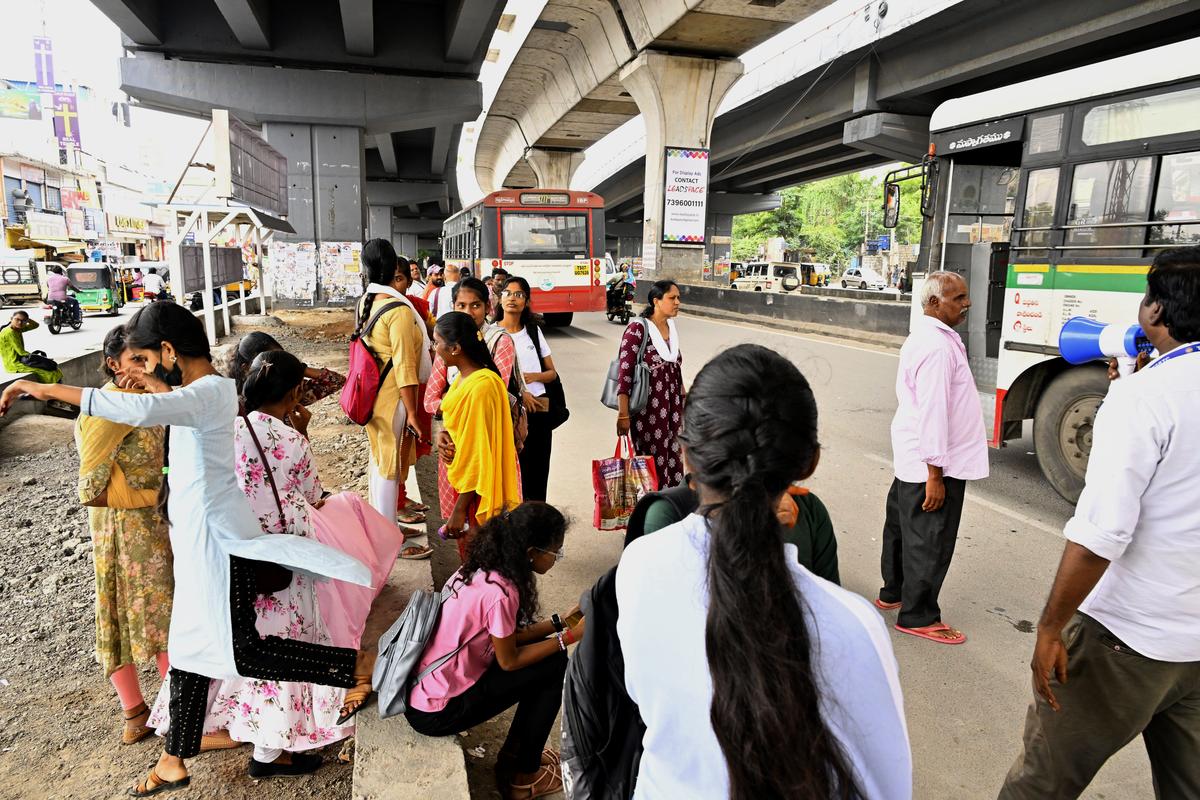Just a month ago, a 16-year-old girl returning home after her first day of college was crushed under the wheels of a Telangana State Road Transport Corporation (TGSRTC) bus, moments after disembarking in the middle of the road in Madhura Nagar, Hyderabad. The disturbing visual went viral on social media, sending shockwaves among daily commuters. In the aftermath of the incident, the TGSRTC launched a passenger safety campaign, urging people to avoid waiting for buses on the carriageway and instead, use footpaths at bus stops. Photographs released by the transport corporation to buttress the point showed a stop which, unfortunately, had no footpaths. The irony made one sit up and take notice of the glaring lack of passenger-friendly infrastructure.
The transport juggernaut is, of course, right; the carriageway is meant for vehicular movement, and pedestrian activity on it is perilous. However, the fact is that many bus stops lack footpaths, either swallowed whole overnight due to road widening or painfully encroached upon inch-by-inch.
A case in point is the bus stop at Panjagutta Crossroads, one of the busiest intersections in Hyderabad. Throughout the day and well into the evening, passengers are forced to navigate through a tide of vehicles driven by unsympathetic drivers and sewage water spilling onto the narrow carriageway to reach this bus stop.
“I usually take the 49M bus to reach the clothing store near Begumpet where I work as a salesman. I have to walk from the Nagarjuna Circle, about 200 metres away, to reach the stop. There is no footpath, because of which you can see hordes of people waiting on the road,” says Sk Jahangir,30.
Farida Banu, who works as a domestic help in the plush locality of Banjara Hills in the city, usually takes the 9 Y/F bus route to drop her daughter off near Borabanda to reach her in-laws’ place. She boards the bus at the ‘Paani ki Tanki’ (water tank) stop, located along the bustling Banjara Hills Road Number 1, opposite an upscale shopping mall. “My stop has both, a footpath and a shelter, but the disembarking point, Sriram Nagar, does not have either,” she says.
In another part of the city, an ordinary bus, plying barely a few metres behind a metro express, groans and grunts as it trudges along the Mandi Mir Alam Road. Serving the 8A route, one of the oldest in the 90-year history of the TGSRTC, once a part of the Nizam’s Road Transport Department, it connects Secunderabad to Chandrayangutta. The bus passes by a disused bus shelter, now an autorickshaw parking stand, near Princess Esin School. Then, from the famous Victoria Hotel, the driver takes a sharp right turn and stops where a father and daughter wait on the carriageway to board. Continuing towards Hafiz Danka Masjid, a rotunda-like mosque in Hyderabad’s Old City, it halts at Shalibanda bus stop, which surprisingly lacks a pavement despite having a bus shelter. Footpaths on the 8A route are also missing at various stops like SBI Shamsheergunj, Aliabad, Falaknuma, and Falaknuma Bridge, and mirror similar deficiencies on the opposite side of the road.
“I take the 9F bus from Falaknuma to Kukatpally. At times, the 8A bus stops here as well. There is no footpath near the Grand Hotel bus stop in Falaknuma. This proves to be a problem during peak traffic hours,” says Syed Kaleem, a final year law student.
Rising bus dependency
Official figures peg the number of bus stops in the Greater Hyderabad Zone (GHZ) at 2,200 and the ridership between 45 lakh and 50 lakh per day, highlighting the necessity for more passenger-friendly infrastructure at bus stops. And with the occupancy in buses soaring after the Telangana government launched the Mahalakshmi scheme, offering free bus travel to women since December last year, the need for passenger-friendly infrastructure becomes more crucial.

The conundrum over pavements and the lack thereof at bus tops is acute with several commuters facing massive difficulties, and safety issues.
| Photo Credit:
NAGARA GOPAL
While independent researchers opine that there is no definitive data of the number of bus stops lacking a footpath, anecdotal evidence indicates that the number is significant, an opinion which TGSRTC officials agree with. A Ministry of Road Transport and Highways document that deals with comprehensive accessibility guidelines for bus stops and terminals emphasises that bus stops should be designed in such a way that they have footpaths and prevent water accumulation, described as “ponding”.
Similarly, the Indian Roads Congress puts pedestrian convenience and safety at the centre. It prescribes that the “minimum width of a clear unobstructed pathway should be 1800 mm in roads of right of way of 10 metre and above”. This means that footpaths in residential and mixed-use areas are at least 1.8 metres wide.
Regarding bus shelters, the guidelines stipulate that the full width of the footpath should be maintained. More specifically, bus stops are required to have a width of 3 metres, depending on the land use of the area.
“There is a dire need for pedestrian-friendly infrastructure where streets are no longer conduits for motor vehicles but are designed to prioritise pedestrians. All public transport trips include walking segments, and as per Census 2011, at least 50% of urban India commutes include a walking component, making pedestrians the single largest category of road users,” points out Venugopal A.V., programme manager for Healthy Streets at the Institute for Transportation and Development Policy (ITDP), highlighting the critical link between road design, pedestrian infrastructure, and public transport. ITDP is a non-profit focussed on developing bus rapid transit systems, promoting biking, walking, and non-motorised transport, and improving private bus operators margins.
Even private motor vehicle users are pedestrians at some phase of the journey, he points out. “Moreover, as cities invest huge budgets in mass transit systems like metro rail, it is critical to ensure the access streets to the transit stops are walkable for efficient first and last-mile connectivity,” he adds.
Whose responsibility is it anyway?
While TGSRTC officials affirm their commitment to passenger safety, they clarify that certain aspects of passenger infrastructure, such as footpaths at bus stops and the construction of bus shelters, are outside their purview. The responsibility for ensuring this infrastructure lies with the Greater Hyderabad Municipal Corporation.
“We do not take up construction of footpaths or bus shelters. During consultations, we advise them [GHMC] where to have the bus shelters. But the tenders for construction are issued by the GHMC,” explains a senior TGSRTC official, requesting anonymity.
Officials of the transport authority say there are 1,375 bus shelters in the GHZ. An estimated 120 have fallen prey to road widening while several others require repair or replacement on account of wear and tear. In what indicates the pressing need for better coordination between these two government agencies, 61 bus shelters were constructed at locations lacking a bus stop.
“There have been instances of bus shelters being constructed keeping in mind the advertisement revenues. Ads are displayed at the top of bus shelters. So, we have seen shelters coming up where there was low passenger footfall,” another TGSRTC officer says.
The TGSRTC has requested that these bus shelters be moved to a more practical location. Moreover, in February this year, the GHMC’s Enforcement Wing removed several bus shelters, including those along the KBR Park, following a furore at its council meeting. Corporators and other public representatives there had alleged that a few advertising agencies were enjoying special privileges by unauthorisedly displaying ads at bus shelters.
Bolstering infrastructure
Despite procedural and jurisdictional challenges, TGSRTC and GHMC in 2022 reached an agreement to construct more bus shelters. The former submitted a comprehensive requirement of 609 bus shelters to GHMC, which was then narrowed down to 411. Plans included constructing shelters along routes from Sagar Crossroads to Miyapur, and Sagar Crossroads to IS Sadan.
Construction of around 80 shelters was started, with several already nearing completion. However, passengers and the transport juggernaut face another pressing issue: disappearing bus bays. Properly designed bus bays, if designed properly, facilitate safe entry and exit for buses, ensuring passengers can board and disembark safely.
“We have only 26 bus bays left in GHZ. Some of these are obstructed by parked vehicles which defeats the very purpose of having them. We have requested the GHMC to help us with land and infrastructure for 226 bus bays,” an official said.
In such a scenario, researchers and experts suggest that government agencies and departments connected to transport coordinate more effectively. They stress the need for a more proactive role of the Unified Metropolitan Transport Authority (UMTA), the urban transportation planning agency of Hyderabad that is tasked with ensuring all forms of urban mass transport, like buses and metro rail, work together efficiently.
“It is crucial for UMTA to be empowered legally as well as financially to develop an integrated mobility vision for the city apart from facilitating coordination, planning, and execution of sustainable transport initiatives among various agencies,” states Venugopal.
Sources say the operational achievements of UMTA have not gone beyond conducting studies and drafting plans about easing traffic. “It needs to play a much larger role and implement big changes. There is also a need for more personnel,” a researcher, unwilling to be named, says.





